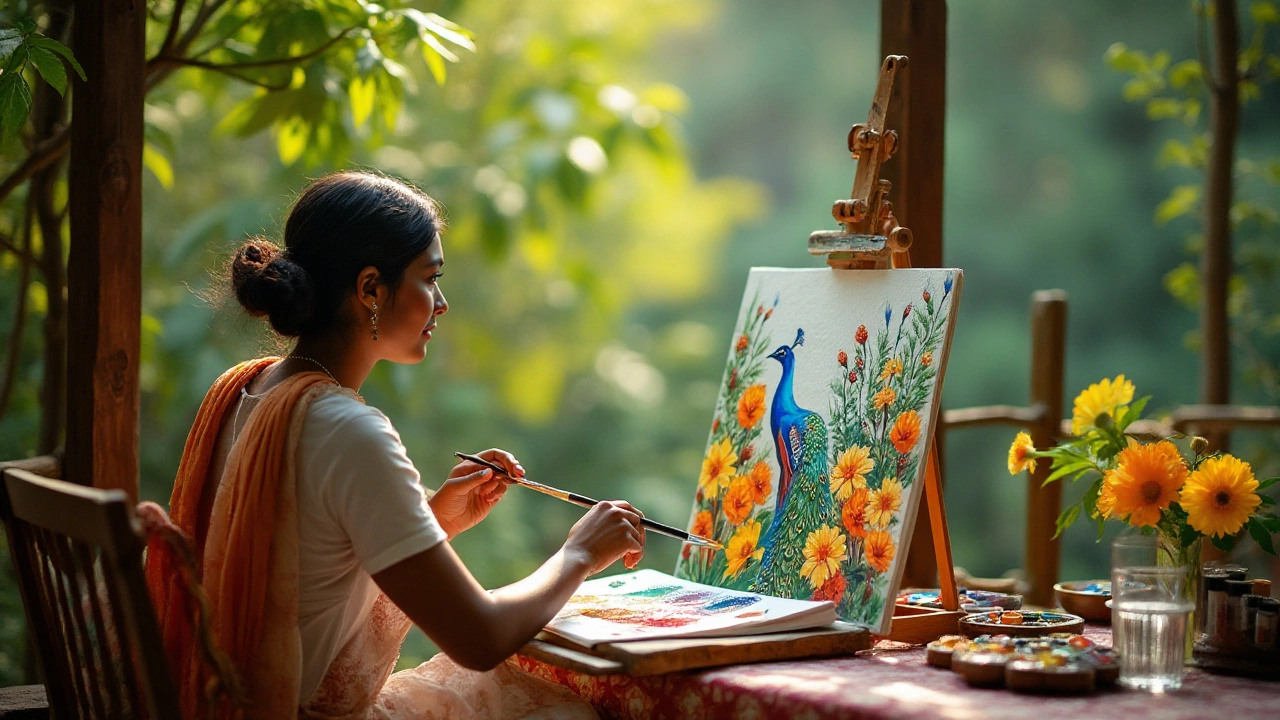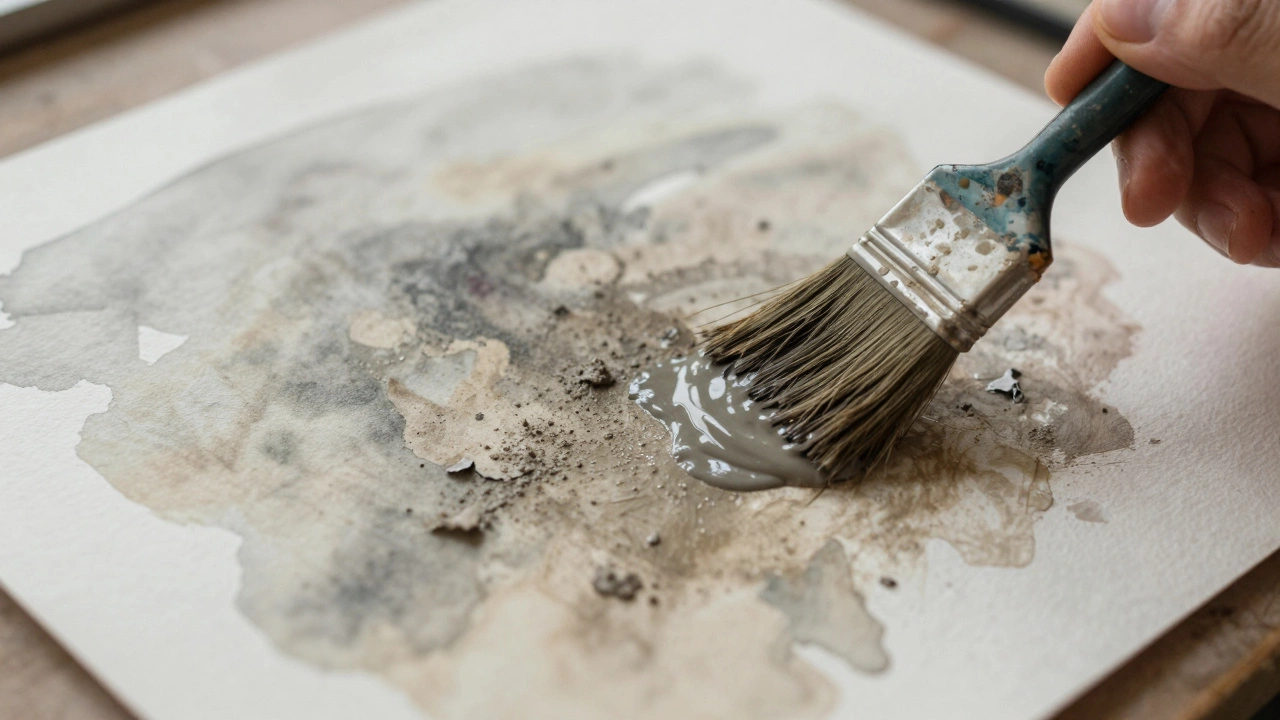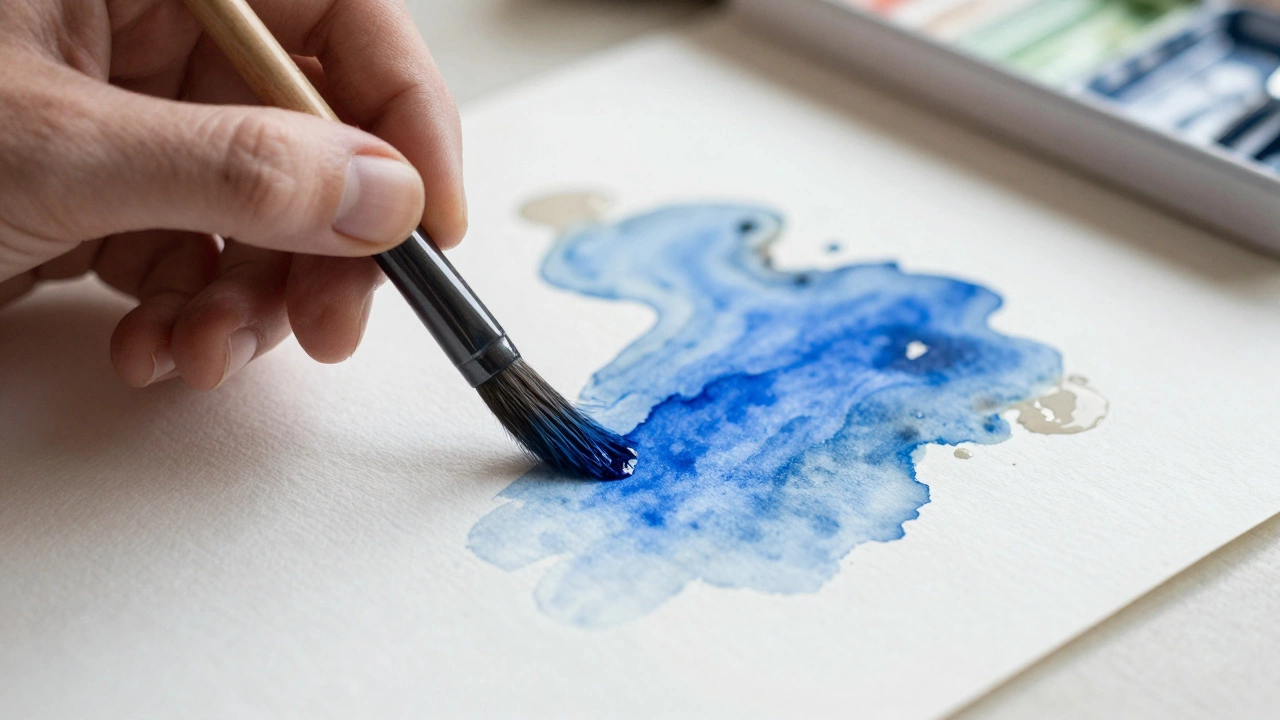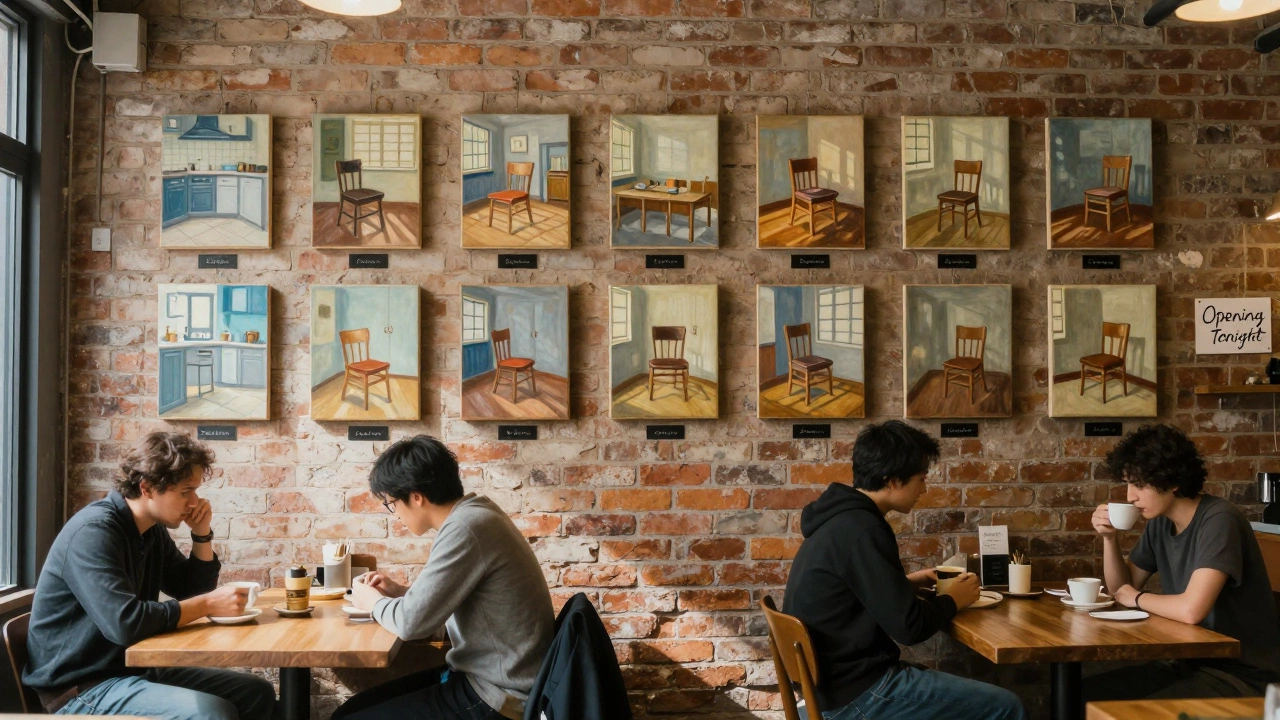Watercolor painting has enchanted people for centuries with its vivid colors and unique qualities. Unlike other art mediums, watercolors provide an unpredictable yet exhilarating experience. When pigment meets water, it creates an ethereal dance of colors that can be both thrilling and frustrating. But therein lies the charm—the endless possibilities and the joy of learning how to guide and embrace the medium's whims.
From the softest wash of color to intense, saturated hues, watercolors can express emotions and scenes in a way that feels alive and dynamic. As you immerse yourself in the world of watercolors, you'll discover why artists are drawn to its challenges and rewards, making it a beloved choice for both novices and seasoned creatives.
- History and Origins
- Unique Characteristics
- Why Artists Love It
- Popular Techniques
- Tips for Beginners
- Healing and Therapeutic Benefits
History and Origins
The art of watercolor painting traces its roots back to ancient times, finding its earliest whispers in the tomb paintings of ancient Egypt and manuscript illustrations in the Middle Ages. This medium was principally used for preparatory sketches or illustrative purposes in illuminated manuscripts, offering rich hues derived from pigments mixed with water. The Renaissance period witnessed a transformation as artists in Europe began to see watercolor as a primary form of artistic expression, with Albrecht Dürer leading the charge in the 16th century. His exquisite botanical studies and landscapes set a standard, displaying the medium's potential for detailed and realistic representation.
Moving into the 18th century, watercolor painting experienced a golden age in England. It rose in prominence largely due to its portability and the country's growing fondness for landscape painting. Artists such as J.M.W. Turner exploited the medium's luminous qualities, paving the way for expressive and atmospheric compositions. Turner's work was revolutionary, harnessing watercolors to articulate both the subtleties and grandeur of natural phenomena. His influential style demonstrated that watercolors could rival oils in their emotional impact.
Watercolor Reach Across the World
The appeal of watercolors was not bound by geography. Across the Atlantic, American artists embraced this medium by the 19th century. Organizations like the American Society of Painters in Watercolor (now the American Watercolor Society) formed to advocate for watercolor painting as a serious art form. This resulted in a deeper exploration and acceptance of the medium, enriching the nation's artistic narrative. The versatility and immediacy of watercolors dovetailed beautifully with the spirit of American art during this time, encouraging a wide range of innovative approaches.
"Watercolors have a life and spirit that is unique to painting. Their ability to capture fleeting moments with a soft yet vibrant touch is what breathes life into every brushstroke," remarked Andrew Wyeth, a renowned American artist, who was known for his watercolor landscapes.
In contemporary times, watercolor painting continues to thrive and evolve, captivating modern artists and hobbyists alike. Advances in materials, such as synthetic brushes and new paper types, have expanded its possibilities. A return to traditional techniques with a modern twist fascinates audiences worldwide, ensuring that watercolor remains at the heart of dynamic and innovative art practices.
Today, watercolor is celebrated not just for its rich history but for its ongoing role in artistic development and appreciation across the globe. It fosters a unique connection between artist and observer, grounding art firmly in its ephemeral and tangible realities. As artists persistently explore new techniques and digital technology to enhance their work, the history and origins of watercolor painting remain an ever-present source of inspiration, bridging past and present in a dialogue of colors and creativity.
Unique Characteristics
Watercolor painting is celebrated for its distinctive qualities that set it apart from other artistic techniques. One of the most notable characteristics of watercolors is their translucency. When applied with the right amount of water, the pigments allow light to reflect through the layers, creating a striking luminescence that is impossible to replicate with opaque mediums like oil or acrylic paints. This transparency offers artists the chance to create depth and a sense of natural light in their works, mimicking the ethereal quality of nature itself.
Another unique feature of watercolors is their fluidity. The blend of water and pigment creates limitless possibilities, allowing colors to flow and merge in unexpected ways. This fluid nature can be both a boon and a challenge, as it requires artists to learn how to control the flow without restraining the freedom that makes watercolor so special. Artists often embrace these happy accidents, letting them guide the composition and mood of their paintings. This spontaneity demands a level of patience and adaptability but offers an exhilarating creative process.
“The unpredictability of watercolor is what keeps me coming back to it. It’s like dancing with the unknown—frustrating at times, yes, but always rewarding.” – a renowned contemporary watercolor artist.
Moreover, watercolor paints are often made with natural pigments mixed with a binder, usually gum arabic, which keeps the pigment in suspension and adhesive once applied to paper. This natural composition means that watercolors often harness the earth's beauty, using mineral or vegetable-based pigments to produce vibrant hues. These elements also make watercolors less toxic than some other painting mediums, a trait that is increasingly appreciated in today's environmentally conscious art community.
Watercolor's portability adds another layer to its appeal, making it ideal for plein air painting. Artists can easily pack a small palette, a few brushes, and a block of watercolor paper, setting up studios just about anywhere. This freedom to paint outdoors captures the immediacy of the changing environment, a quality cherished by artists looking to faithfully render fleeting moments of natural beauty. A study showed that more than 60% of outdoor artists prefer watercolors for this very reason, influenced by the technique's portability and adaptability.
Lastly, watercolors possess an unrivaled versatility. From delicate washes to bold, expressive strokes, artists can achieve a wide range of textures and finishes. Techniques like wet-on-wet, dry brush, and glazing offer endless opportunities to experiment and innovate. Whether striving for photorealism or abstract expression, watercolor accommodates various artistic visions, making it a beloved choice for creators who enjoy pushing the boundaries of traditional art forms.
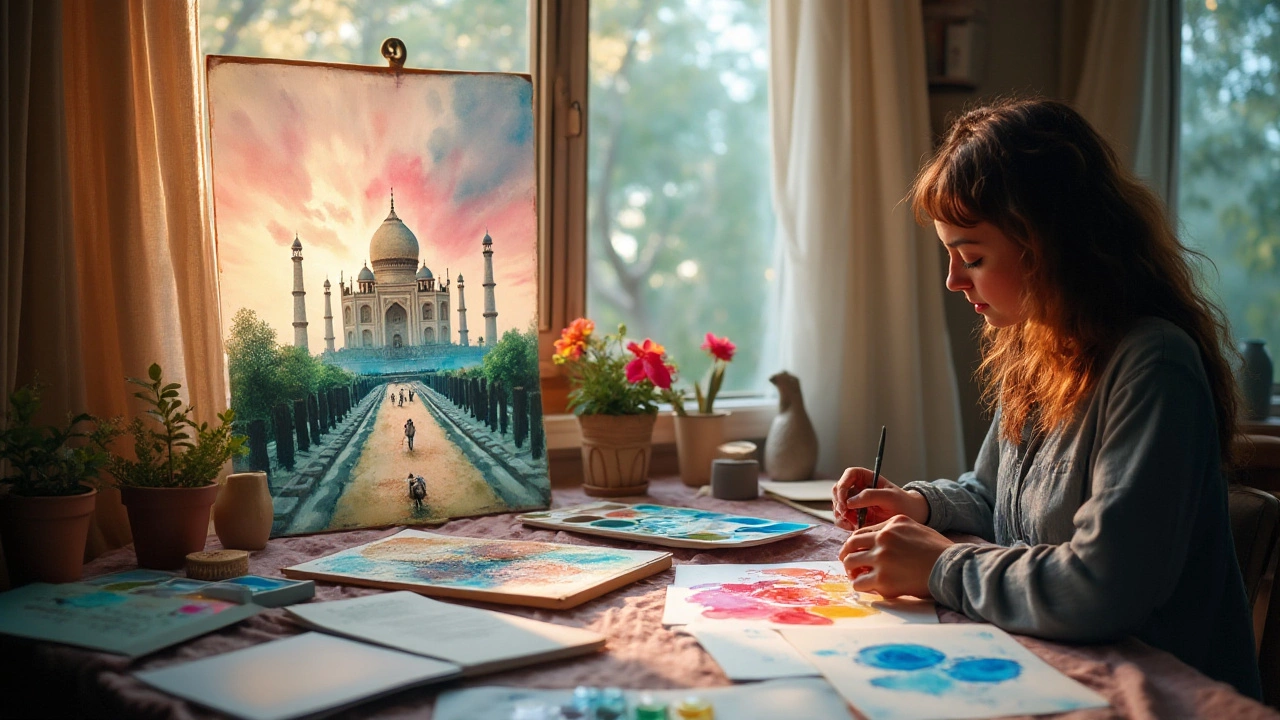
Why Artists Love It
Artists are drawn to watercolor painting for its unique ability to capture both the essence and the fleeting nature of a moment with remarkable vibrancy. Unlike heavier mediums such as oils or acrylics, watercolors offer a light transparency that allows the paper to show through, creating a sense of luminosity. This quality can profoundly affect the mood of the work, making it seem as if the light is emanating from within the painting itself. The interplay between water and pigment mirrors the delicate balance found in nature, making it an ideal medium for depicting landscapes, seascapes, and ethereal scenes.
The spontaneous nature of watercolor also appeals to artists' desire for unplanned creativity. While some artists meticulously plan their pieces, many find joy in the unpredictability of the medium. The way colors blend and spread can be both a challenge and a delightful surprise, adding a dynamic quality to the creative process. The skills required to manage this unpredictability push artists to refine their techniques and embrace mistakes as part of the art, fostering a deeper connection with their work.
The versatility of watercolors is another aspect that artists love. From soft washes to bold and detailed rendering, this medium allows for a range of expression that can suit many styles and subjects. Artists can switch between the delicate strokes required for botanical illustrations to the expressive, sweeping gestures needed for abstract pieces, all with the same set of paints. This adaptability has made watercolor a favorite among artists, allowing them to explore different themes and push their creative boundaries.
Many artists appreciate the portability and minimal setup required for watercolor painting. A simple palette, a brush, and a pad of paper fit easily into a bag, making it an accessible hobby for those who may not have the space or means for more extensive art setups. This ease of transport encourages painting en plein air—capturing the world directly from life—which can lend authenticity and immediacy to the work, infusing landscapes with the artist's immediate emotional responses to the environment.
An interesting fact that often comes up in discussions about watercolor's allure involves its historical significance. Traditionally used for preliminary sketches and studies by great masters, watercolors have long been cherished for their ability to capture swift impressions. Artists such as J.M.W. Turner and John Singer Sargent elevated these applications to new heights, inspiring countless others with their pioneering work in watercolors.
A widely cherished sentiment among professional watercolorists is expressed by Marion Boddy-Evans: "Watercolors can be ridiculously unpredictable and infuriatingly beautiful."
Also of note, is the growing recognition of the medium’s therapeutic benefits. Engaging in watercolor can be meditative, offering a mental escape and a chance to focus inward. For those who practice it, the rhythmic strokes and the flow of water can induce a calming state, similar to mindfulness practices. This stress-relieving aspect is particularly appealing in today's busy world, promoting mental well-being through creative expression.
Ultimately, the reasons why artists love watercolor painting are as varied as the artists themselves. Whether it’s the challenge, the beauty, the versatility, or the freedom it offers, watercolors hold a special place in the hearts of those who love to create, making it a truly timeless medium.
Popular Techniques
When diving into the vibrant world of watercolor painting, one can quickly become fascinated by the myriad of painting techniques that are employed by both amateur and seasoned artists to bring their visions to life. The sheer variety is both stunning and satisfying, offering every artist avenues to explore creativity and expression. One of the most celebrated techniques is the wet-on-wet approach. This method involves applying wet paint onto an already wet surface. The beauty of this technique lies in the seamless blend of colors, allowing the hues to naturally flow into each other, creating soft edges and gradations that are often unexpected and breathtakingly organic. Many artists like to use this approach when painting natural elements such as skies, bodies of water, or soft abstract forms.
In contrast, there's the wet-on-dry technique, where wet pigment is applied on a dry surface, giving the artist more control over the brush strokes and the intensity of color. This technique is commonly used when an artist wants to achieve sharp, defined edges and details. It's a favorite when painting subjects with precise detail like architecture or figurative works. Another intriguing strategy is the dry brush technique. This involves using a minimal amount of water, which results in a textured effect allowing small details and textures to emerge vividly. Artists often choose the dry brush for adding detail or texture to surfaces like tree barks, rocky surfaces, or fur.
"Watercolor is a garden of delights, a series of pleasant surprises," says John Singer Sargent, a master of this medium.
An important technique to mention is lifting, where artists remove paint from the paper. This can be used for creating highlights and correcting mistakes. Through various tools, like a damp sponge or tissue, paint can be gently taken off the surface, allowing the emergence of lighter areas that can convey depth and dimension. Additionally, spattering is a playful option often used to introduce random splashes of texture to a painting. By flicking paint from a brush onto the paper, it adds an element of spontaneity and movement. This method can simulate textures like the speckled surface of a stone or the delicate spots of foliage.
Moreover, resist techniques such as using masking fluid help keep specific areas untouched by paint, preserving the paper’s whiteness and ensuring precision in complex compositions. This is particularly useful when trying to recreate the brilliance of light or intricate patterns. Creative expression through these techniques is boundless, and they open up expansive possibilities for artistic exploration. The use of salt for texturing is also an engaging secret. By sprinkling salt on a wet wash, artists can produce an intriguing effect of starry or textured surfaces, a clever way to simulate snow, sand, or the starry sky. The outcome is often unpredictable, inviting artists to embrace the element of surprise inherent in this dynamic medium.
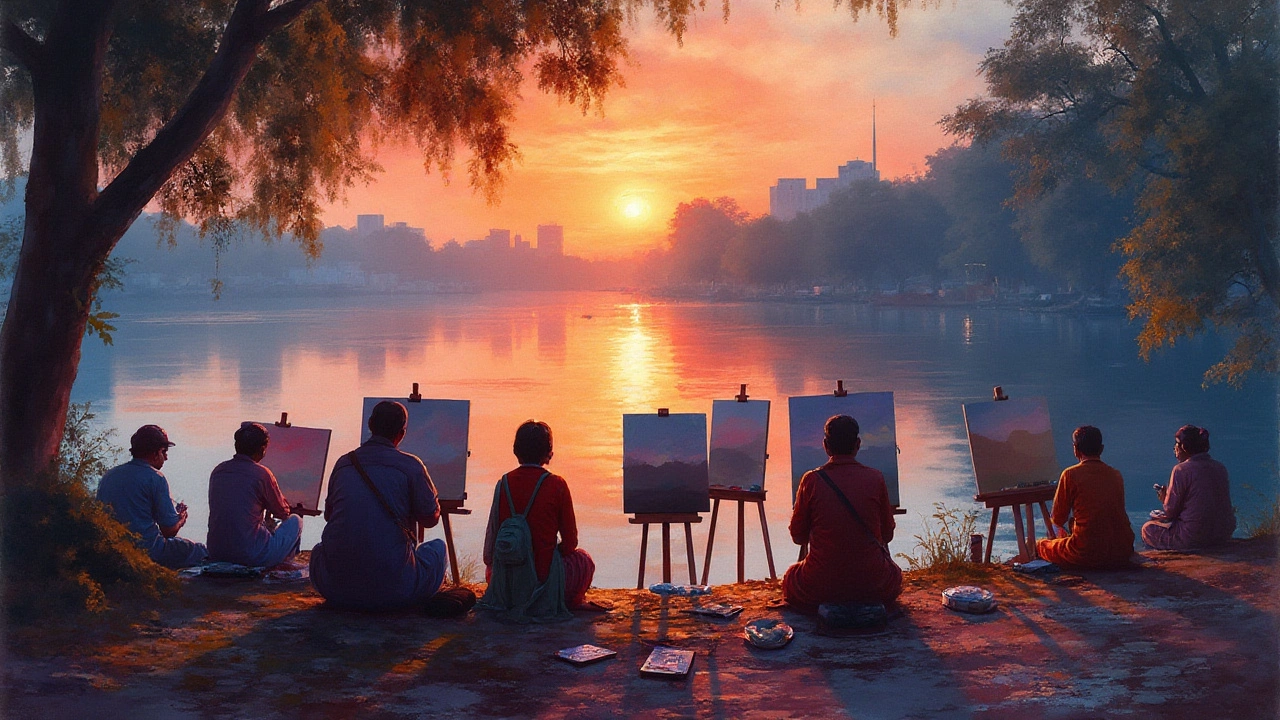
Tips for Beginners
Diving into the world of watercolor painting can feel like stepping into a realm where your creative spirit can truly soar. For beginners, the journey may seem daunting at first, but with the right guidance, it becomes an adventure brimming with discovery and growth. First and foremost, it's important to embrace the uniqueness of watercolors. This medium is all about letting go and allowing water to do much of the work. Focus on becoming comfortable with its unpredictable nature — it's a dance of control and surrender.
To set the stage for your watercolor adventure, start by investing in high-quality paper, brushes, and paints. Professional-grade materials, although a bit pricier, offer better texture, color payoff, and durability. For a beginner, a good rule of thumb is to purchase cold-pressed paper with at least 300 GSM weight, which can handle multiple layers without buckling. When it comes to brushes, having a variety of sizes, particularly round and flat ones, can provide versatility in creating different strokes and effects.
"Watercolors bring out the artist's soul, allowing instinct and innovation to merge on paper." — David MacKay, Artist and Educator
Understanding basic techniques can significantly pave your way toward proficiency. Start with color washes—these are the backbone of watercolor painting. Master the flat wash and the graded wash, both crucial for creating backgrounds and gradients. Practice blending colors on a wet surface to achieve seamless transitions, a hallmark of this medium's beauty. Wet-on-wet and wet-on-dry techniques each have distinct characteristics, and learning when and how to apply each can change the dynamics of your painting.
Explore the play of light and shade by experimenting with different amounts of water. Control your paint's transparency by adjusting water levels; lighter washes create luminosity, while thicker paint introduces depth and shadow. Layers are fundamental in adding depth to your artworks, so practice applying multiple washes, allowing each to dry completely before painting anew. This will elevate your paintings from flat to full of life.
Practice and Patience
Perhaps the most vital tip for beginners in watercolor painting is to practice regularly and exercise patience. With consistent practice, your hand becomes steadier, and your understanding of color synergy grows. Don't be discouraged by challenges; every stroke teaches you something new. Consider keeping a sketchbook dedicated to watercolor experiments. Use it to explore free-form doodling or try and replicate objects from real life; this builds both skill and confidence over time. Remember, every accomplished artist started as a beginner, just like you.
Healing and Therapeutic Benefits
Watercolor painting has long been celebrated not only for its aesthetic charm but also for the profound healing and therapeutic advantages it offers to individuals. Art therapy has become an increasingly popular means of promoting mental health, and watercolor paints serve as a perfect tool for this purpose. Its easy-to-use nature allows people of all ages and abilities to engage in creative expression. Engaging with watercolors helps reduce stress and brings about tranquility by enabling artists to shift their focus from worries of daily life to the vibrant hues of their canvas. The movement of paint and water across paper acts as a soothing, meditative process that encourages introspection and releases pent-up emotions.
Psychological studies suggest that creating art can aid in the reduction of anxiety symptoms and offer a constructive way for individuals to deal with trauma. Watercolors, with their serene flow and delicate layering, invite the creator to explore emotions gently, facilitating emotional healing. Specifically, the activity of mixing colors and witnessing their transformation can mirror the process of resolving complex feelings within oneself. Defining boundaries can often serve as a metaphor for setting personal limits, and blending colors can reflect the understanding and acceptance of the complexities of human emotions.
The therapeutic potential of art techniques like watercolor painting is not just anecdotal. There is growing evidence and acknowledgment within the psychological community about the intrinsic benefits art brings to mental well-being. The Art Therapy Credentials Board emphasizes the practice's power to enhance cognitive functions and affective experiences. In art therapy sessions, individuals often experience a growing sense of personal achievement and self-worth, qualities that are essential for overcoming various life challenges. This sense of achievement can vastly improve overall mood and can be especially uplifting for individuals dealing with depression or grief.
"Art, particularly a medium like watercolor that can invoke unexpected and beautiful results, allows us to connect non-verbally with parts of our psyche that words can't reach," says a leading art therapist in Sydney.
In cases where traditional medication or therapies fail to yield satisfactory results, art therapy can provide an alternative or supplementary method to improve mental health outcomes. The physical process of blending water with pigment might be simple, yet its potential to mend the complexities of the human mind is profound. The fact that watercolors are non-toxic and easy to clean up adds to their attractiveness as a therapeutic medium for everyone, including children and the elderly. Simple exercises like painting a rainbow or using shapes and lines to express feelings can significantly boost one’s mood and creativity without being overwhelming.
Whether used in a formal therapeutic setting or as an individual pastime, watercolor painting offers a non-threatening method of expression that can speak across any language barrier. This inclusivity is what makes it such an invaluable tool for healing. In a world where we often struggle to find the words to articulate our inner experiences, watercolors offer a visual voice that is as expressive as it is beautiful. The harmonizing dance of water and color allows us to explore our emotions freely, unlocking the doors to personal growth and healing.
